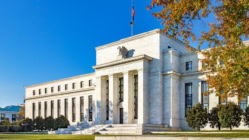
Several savvy agents responded and pointed out that I forgot one more way borrowers can get credits for closing costs: agents can credit a portion of their commissions too if they so desire.
We never recommend that to borrowers, because far be it from us to ever give away someone else’s commission, but it is an option that agents should be aware of, and I was remiss for not mentioning it.
Why’s Lumber So Expensive When There’s A Wood Glut?
Last Halloween, one of our team members dressed up as a lumberjack to make fun of himself.
He is very tall and thin, so he deemed himself “Scrawny the Lumberjack” as a takeoff from “Brawny the Lumberjack” from the paper towel brand.
It was pretty funny, but he was probably far closer to the mark than he realized because he is an extraordinarily bright UCLA grad who is much closer to today’s “lumberjacks” than he probably realizes – I explain why below.
Today’s blog comes from this excellent WSJ/Gimlet Podcast, in which “The Strange Economics of the Lumber Market” are explained in full and fascinating detail.
Lumber prices are at all-time record highs because demand is far higher than expected while supplies are very restricted.
Way Too Much Raw Wood
What makes this fascinating, though, is the fact that there is a huge glut of raw wood or logs, and the prices for such logs remain at record LOWS!
Raw wood prices are currently about $27 per ton, or $10 LESS than the $37 per ton price tree growers were getting in 1995.
There is an enormous glut of wood because the government started offering incentives to grow more wood in the South in the early 1980s.
300 years ago, the entire South was nothing but forests, but they were cleared for cotton and tobacco farming.
To stop the deforestation and to restore the land, the government offered strong incentives to plant trees on the land to replace crop farming.
A lot more landowners than anticipated took advantage of the program without anticipating the supply gluts that would hit 30+ years (the time it takes for trees to mature) later.
And here we are with way too many trees and way too few sawmills to process the trees into lumber.
Why Too Few Sawmills?
There are three reasons why: (1) Many sawmills shut down after the 2008 housing crisis because demand fell to zero; (2) many shut down last spring because of COVID and have yet to fully revive; and (3) the cost to build new mills is prohibitively expensive in this day and age because of their complexity; sawmills are all about technology and software now. So, they need a lot more highly trained and really smart “Scrawnies” as opposed to “Brawnies.” 😊
In any case, this is why lumber supplies are so restricted and why cut lumber prices are so high.
How Does This Affect Mortgages And Housing?
I thought you’d never ask.
This bodes extremely well for both housing and mortgages, and this is why.
The above-described situation makes it extremely likely that cut and processed lumber prices will fall significantly at some point as lumber mills come back to life, are expanded, or are built anew.
This is very positive for housing because lumber is a key raw ingredient that is helping to push up prices of new homes right now. A fall in lumber prices, obviously, will make building cheaper and hopefully bring down prices.
This is even more encouraging for mortgages though because it is one more indication that all of the “inflation” we are hearing about right now really is just temporary.
And that is encouraging because inflation fears push interest rates up as much as any other economic indicator.
Barry Habib of MBS Highway says that interest rates will likely be 1/2% (or more) higher by the end of the summer because of inflation fears. But he also has been insisting that much of the inflation we are seeing (and will see) is “transitory” and that it will dissipate as COVID-damaged supply chains are repaired.
This lumber situation implies that Mr. Habib, whose predictions have proved to be amazingly accurate over the years, might be right again.
So, here’s to another refi boom in 2022!
Sign up to receive our blog daily
























